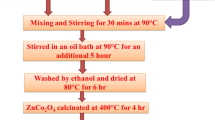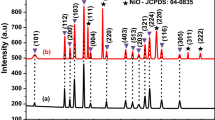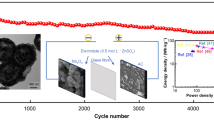Abstract
Transition metal chalcogenides have garnered wide attention of the researchers in energy storage and conversion domains owing to their superior electronic conductivity, mechanical and thermal constancy. Zinc Sulfide (ZnS) has been identified as one of the most important II–VI semiconductor, with a band gap of 3.5–3.8 eV. Excellent ion accessibility and charge storage ability of nanosized ZnS makes this a prospective material in the field of energy storage. Besides ZnS nanoparticle possess advantages such as good electric conductivity, low diffusion resistance, fast electron transportation, non-toxic nature etc. It is a lightweight and cost effective material compared to other metal sulfides. Reports are available on supercapacitor electrodes based on different types of ZnS nanocomposites. However, investigation on the variation of this material’s energy storage efficiency with metal doping and increased particle size are comparatively less. ZnS particles with microsphere morphology show enhanced reversibility due to less self-aggregation and volume expansion. In this work we report the synthesis and electrochemical studies of pure & nickel (Ni) doped ZnS microspheres. The synthesis of pure and Ni doped ZnS microspheres were carried out by hydrothermal method. The crystal structure, phase composition, and microstructure of the samples were analyzed by X-ray diffractometer (XRD) and Field Emission Scanning Electron Microscope (FESEM) respectively. The electrochemical behavior of pure ZnS and Ni doped ZnS microspheres were examined by means of Electrochemical Impedance Spectroscopy, Cyclic Voltammetry, and Galvanostatic charge–discharge. At 5A g−1 current density, Ni doped ZnS microspheres exhibited an enhanced specific capacitance of 104.2 F g−1 where pure ZnS microspheres showed 67.75F g−1.







Similar content being viewed by others
Data availability
We have the original data and material with us.
References
X. Li, W. Zhang, X. Wang, F. Gao, J. Fang, Disodium edetate as a promising interfacial material for inverted organic solar cells and the device performance optimization. ACS Appl Mater Interfaces 6, 20569–20573 (2014)
S. Kim, K. Kang, S. Kim, J. Jang, A one-step practical strategy to enhance overall supercapacitor performance. RSC Adv 4, 59310–59314 (2014)
P. Yang, W. Mai, Flexible solid-state electrochemical super capacitors. Nano Energy 8, 274–290 (2014)
H. Wang, L. Shi, T. Yan, J. Zhang, Q. Zhonga, D. Zhang, Design of graphene coated hollow mesoporous carbon spheres as high performance electrodes for capacitive deionization. J Mater Chem A 2, 4739–4750 (2014)
G. Garnweitner, D. Xue, Crystal engineering for electrochemical applications. CrystEngComm 22, 1498–1499 (2020)
X. Liang, K. Chen, D. Xue, A flexible and ultrahigh energy density capacitor via enhancing surface/interface of carbon cloth supported colloids. Adv Energy Mater 8, 1703329 (2018)
L. Zhang, X.S. Zhao, Carbon-based materials as supercapacitor electrodes. Chem Soc Rev 38, 2520–2531 (2009)
L. Bao, J. Zang, X. Li, Flexible Zn2SnO4/MnO2 core/shell Nanocable Carbon microfiber hybrid composites for high-performance supercapacitor electrodes. Nano Lett 11, 1215–1220 (2011)
X. Tian, X. Sun, Z. Jiang, Z.-J. Jiang, X. Hao, D. Shao, T. Maiyalagan, Exploration of the active center structure of nitrogen-doped graphene for control over the growth of Co3O4 for a high-performance supercapacitor. ACS Appl Energy Mater 1, 143–153 (2018)
R.S. Kate, S.A. Khalate, R.J. Deokate, Overview of nanostructured metal oxides and pure nickel oxide (NiO) electrodes for supercapacitors: a review. J Alloy Compd 734, 89–111 (2018)
M.R. Gao, Y.F. Xu, J. Jiang, S.H. Yu, Nanostructured metal chalcogenides: synthesis, modification, and applications in energy conversion and storage devices. Chem Soc Rev 42, 2986–3017 (2013)
J. Jiang, Y. Li, J. Liu, X. Huang, C. Yuan, X.W.D. Lou, Recent advances in metal oxide-based electrode architecture design for electrochemical energy storage. Adv Mater 24, 5166–5180 (2012)
K. Chen, D. Xue, Rare earth and transitional metal colloidal super capacitors. Sci China Technol Sci 58, 1768–1778 (2015)
K. Chen, S. Song, D. Xue, An ionic aqueous pseudocapacitor system: electroactive ions in both a salt electrode and redox electrolyte. RSC Adv 4, 23338–23343 (2014)
X. Wang, Hu Jiangjiang, W. Liu, G. Wang, J. An, J. Lian, Ni–Zn binary system hydroxide, oxide and sulfide materials: synthesis and high supercapacitor performance. J Mater Chem A 3, 23333–23344 (2015)
M.S. Javed, J. Chen, L. Chen, Yi Xi, C. Zhang, B. Wana, Hu Chenguo, Flexible full-solid state supercapacitors based on zinc sulfide spheres growing on carbon textile with superior charge storage. J Mater Chem A 4, 667–674 (2016)
M.S. Javed, S. Dai, M. Wang, Y. Xi, Q. Leng, D. Guo, C. Hu, Faradic redox active material of Cu7S4 nanowires with a high conductance for flexible solid state super capacitors. Nanoscale 7, 13610–13618 (2015)
M.S. Javed, S. Dai, M. Wang et al., High performance solid state flexible supercapacitor based on molybdenum sulfide hierarchical nanospheres. J Power Sources 285, 63–69 (2015)
H. Pang, C. Wei, X. Li et al., Microwave-assisted synthesis of NiS2 nanostructures for supercapacitors and cocatalytic enhancing photocatalytic H2 production. Sci Rep 4(1–8), 3577 (2014)
R. Rakhi, N.A. Alhebshi, D. Anjum, H. Alshareef, Nanostructured cobalt sulfide-on-fiber with tunable morphology as electrodes for asymmetric hybrid super capacitors. J Mater Chem A 2, 16190–16198 (2014)
W. Tian, C. Zhang, T.Y. Zhai et al., Flexible ultraviolet photodetectors with broad photoresponse based on branched ZnS-ZnO heterostructure nanofilms. Adv Mater 26, 3088–3093 (2014)
L.F. Hu, M. Chen, W.Z. Shan et al., Stacking-order-dependent optoelectronic properties of bilayer nanofilm photodetectors made from hollow ZnS and ZnO microspheres. Adv Mater 24, 5872–5877 (2012)
S. Stankovich, D.A. Dikin, G.H.B. Dommett et al., Graphene-based composite materials. Nature 442, 282–286 (2006)
F.J. Chen, Y.L. Cao, D.Z. Jia, A facile route for the synthesis of ZnS rods with excellent photocatalytic activity. Chem Eng J 234, 223–231 (2013)
S. Dilpazir, M. Siddiq, A. Iqbal, Synthesis of zinc sulphide nanostructures by Co-precipitation: effects of doping on electro-optical properties. Kenkyu J Nanotechnol Nanosci 1, 34–39 (2015)
R. Ramachandran, M. Saranya, P. Kollu, B.P.C. Raghupathy, S.K. Jeong, A.N. Grace, Solvothermal synthesis of zinc sulfide decorated graphene (ZnS/G) nanocomposites for novel supercapacitor electrodes. Electrochim Acta 178, 647–657 (2015)
S. Zhang, B. Yin, H. Jiang, F. Qu, A. Umar, X. Wu, Hybrid ZnO/ ZnS nanoforests as the electrode materials for high performance supercapacitor application. Dalton Trans 44, 2409–2415 (2015)
X. Hou, T. Peng, J. Cheng et al., Ultrathin ZnS nanosheet/carbon nanotube hybrid electrode for high-performance flexible all-solid-state supercapacitor. Nano Res 10, 2570–2583 (2017)
S. Xie, J. Gou, B. Liu, C. Liu, Synthesis of cobalt-doped nickel sulfide nanomaterials with rich edge sites as high-performance supercapacitor electrode materials. Inorg Chem Front 5, 1218–1225 (2018)
M.M. Rashad, D.A. Rayan, K. El-Barawy, Hydrothermal synthesis and magnetic properties of Mn doped ZnS nanoparticles. J Phys Conf Ser 200, 072077 (2010)
R.B. Pujari, A.C. Lokhande, A.A. Yadav, J.H. Kim, C.D. Lokhande, Synthesis of MnS microfibers for high performance flexible supercapacitors. Mater Des 108, 510–517 (2016)
N. Sabari Arul, L.S. Cavalcante, J.I. Han, Facile synthesis of ZnS/MnS nanocomposites for supercapacitor applications. J Solid State Electrochem 22, 303–313 (2018)
X. Feng, N. Chen, Y. Zhang et al., The self-assembly of shape controlled functionalized graphene–MnO2 composites for application as super capacitors. J Mater Chem A 2, 9178–9184 (2014)
H. Li, M. Yu, F. Wang et al., Amorphous nickel hydroxide nanospheres with ultrahigh capacitance and energy density as electrochemical pseudocapacitor materials. Nat Commun 4, 1894 (2013)
Acknowledgments
The authors are grateful to Nanotechnology Research Centre and SRM Central Instrumentation Facility of SRM Institute of Science and Technology, Kattankulathur, Tamil Nadu, India for their support in our research work. The authors T.Vijayakumar and Aleena Rose acknowledge financial assistance (Grant No. B.19012/57/ 2016-II) received from the Department of Space, Government of India through RESPOND project and the SRM University through selective excellence initiative award. The author T. Maiyalagan acknowledges the financial support from the Department of Science and Technology-Science and Engineering Research Board [DST-SERB; No. ECR/2016/002025], through Early Career Research Award and support of Scheme for Promotion of Academic and Research Collaboration (SPARC) of the Ministry of Human Resource Development (MHRD), Government of India, SPARC Grant No: SPARC/2018-2019/P1122/SL. Research Board [DST-SERB No. ECR/2016/002025], India, received through Early Career Research Award.
Funding
This work was not funded and no specific grant was received.
Author information
Authors and Affiliations
Contributions
All authors contributed to the design of the research work. Material synthesis, characterizations, and interpretation of the results were performed by Aleena Rose and B. Shunmugapriya. The manuscript was written by Aleena Rose. The authors T. Vijayakumar and T. Maiyalagan pointed out major corrections and revised the manuscript. All authors read and accepted the final manuscript.
Corresponding author
Ethics declarations
Conflict of interest
The authors declare that they have no conflict of interest.
Additional information
Publisher's Note
Springer Nature remains neutral with regard to jurisdictional claims in published maps and institutional affiliations.
Electronic supplementary material
Below is the link to the electronic supplementary material.
Rights and permissions
About this article
Cite this article
Rose, A., Shunmugapriya, B., Maiyalagan, T. et al. Investigation on the electrochemical properties of hydrothermally synthesized pure and Nickel doped Zinc Sulfide microspheres for supercapacitor electrode applications. J Mater Sci: Mater Electron 31, 19204–19212 (2020). https://doi.org/10.1007/s10854-020-04456-7
Received:
Accepted:
Published:
Issue Date:
DOI: https://doi.org/10.1007/s10854-020-04456-7




